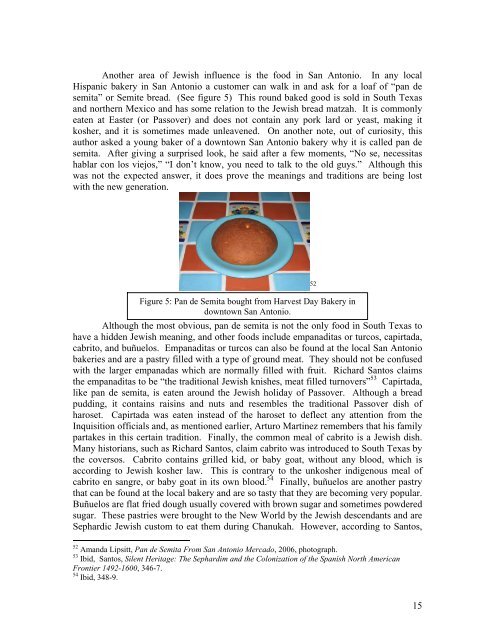The Secret Society: Descendants of Crypto-Jews in the San Antonio ...
The Secret Society: Descendants of Crypto-Jews in the San Antonio ...
The Secret Society: Descendants of Crypto-Jews in the San Antonio ...
You also want an ePaper? Increase the reach of your titles
YUMPU automatically turns print PDFs into web optimized ePapers that Google loves.
Ano<strong>the</strong>r area <strong>of</strong> Jewish <strong>in</strong>fluence is <strong>the</strong> food <strong>in</strong> <strong>San</strong> <strong>Antonio</strong>. In any local<br />
Hispanic bakery <strong>in</strong> <strong>San</strong> <strong>Antonio</strong> a customer can walk <strong>in</strong> and ask for a loaf <strong>of</strong> “pan de<br />
semita” or Semite bread. (See figure 5) This round baked good is sold <strong>in</strong> South Texas<br />
and nor<strong>the</strong>rn Mexico and has some relation to <strong>the</strong> Jewish bread matzah. It is commonly<br />
eaten at Easter (or Passover) and does not conta<strong>in</strong> any pork lard or yeast, mak<strong>in</strong>g it<br />
kosher, and it is sometimes made unleavened. On ano<strong>the</strong>r note, out <strong>of</strong> curiosity, this<br />
author asked a young baker <strong>of</strong> a downtown <strong>San</strong> <strong>Antonio</strong> bakery why it is called pan de<br />
semita. After giv<strong>in</strong>g a surprised look, he said after a few moments, “No se, necessitas<br />
hablar con los viejos,” “I don’t know, you need to talk to <strong>the</strong> old guys.” Although this<br />
was not <strong>the</strong> expected answer, it does prove <strong>the</strong> mean<strong>in</strong>gs and traditions are be<strong>in</strong>g lost<br />
with <strong>the</strong> new generation.<br />
Figure 5: Pan de Semita bought from Harvest Day Bakery <strong>in</strong><br />
downtown <strong>San</strong> <strong>Antonio</strong>.<br />
Although <strong>the</strong> most obvious, pan de semita is not <strong>the</strong> only food <strong>in</strong> South Texas to<br />
have a hidden Jewish mean<strong>in</strong>g, and o<strong>the</strong>r foods <strong>in</strong>clude empanaditas or turcos, capirtada,<br />
cabrito, and buñuelos. Empanaditas or turcos can also be found at <strong>the</strong> local <strong>San</strong> <strong>Antonio</strong><br />
bakeries and are a pastry filled with a type <strong>of</strong> ground meat. <strong>The</strong>y should not be confused<br />
with <strong>the</strong> larger empanadas which are normally filled with fruit. Richard <strong>San</strong>tos claims<br />
<strong>the</strong> empanaditas to be “<strong>the</strong> traditional Jewish knishes, meat filled turnovers” 53 Capirtada,<br />
like pan de semita, is eaten around <strong>the</strong> Jewish holiday <strong>of</strong> Passover. Although a bread<br />
pudd<strong>in</strong>g, it conta<strong>in</strong>s rais<strong>in</strong>s and nuts and resembles <strong>the</strong> traditional Passover dish <strong>of</strong><br />
haroset. Capirtada was eaten <strong>in</strong>stead <strong>of</strong> <strong>the</strong> haroset to deflect any attention from <strong>the</strong><br />
Inquisition <strong>of</strong>ficials and, as mentioned earlier, Arturo Mart<strong>in</strong>ez remembers that his family<br />
partakes <strong>in</strong> this certa<strong>in</strong> tradition. F<strong>in</strong>ally, <strong>the</strong> common meal <strong>of</strong> cabrito is a Jewish dish.<br />
Many historians, such as Richard <strong>San</strong>tos, claim cabrito was <strong>in</strong>troduced to South Texas by<br />
<strong>the</strong> coversos. Cabrito conta<strong>in</strong>s grilled kid, or baby goat, without any blood, which is<br />
accord<strong>in</strong>g to Jewish kosher law. This is contrary to <strong>the</strong> unkosher <strong>in</strong>digenous meal <strong>of</strong><br />
cabrito en sangre, or baby goat <strong>in</strong> its own blood. 54 F<strong>in</strong>ally, buñuelos are ano<strong>the</strong>r pastry<br />
that can be found at <strong>the</strong> local bakery and are so tasty that <strong>the</strong>y are becom<strong>in</strong>g very popular.<br />
Buñuelos are flat fried dough usually covered with brown sugar and sometimes powdered<br />
sugar. <strong>The</strong>se pastries were brought to <strong>the</strong> New World by <strong>the</strong> Jewish descendants and are<br />
Sephardic Jewish custom to eat <strong>the</strong>m dur<strong>in</strong>g Chanukah. However, accord<strong>in</strong>g to <strong>San</strong>tos,<br />
52 Amanda Lipsitt, Pan de Semita From <strong>San</strong> <strong>Antonio</strong> Mercado, 2006, photograph.<br />
53 Ibid, <strong>San</strong>tos, Silent Heritage: <strong>The</strong> Sephardim and <strong>the</strong> Colonization <strong>of</strong> <strong>the</strong> Spanish North American<br />
Frontier 1492-1600, 346-7.<br />
54 Ibid, 348-9.<br />
52<br />
15
















